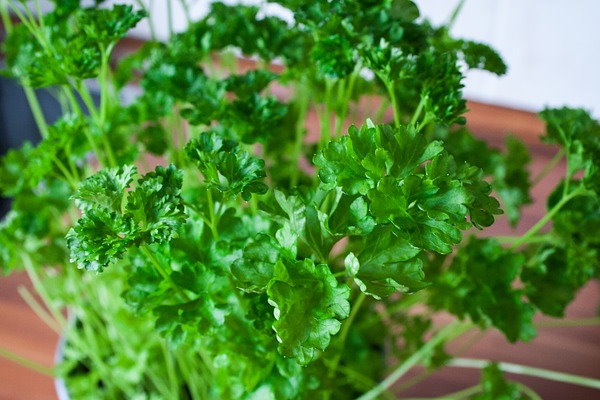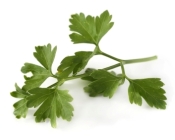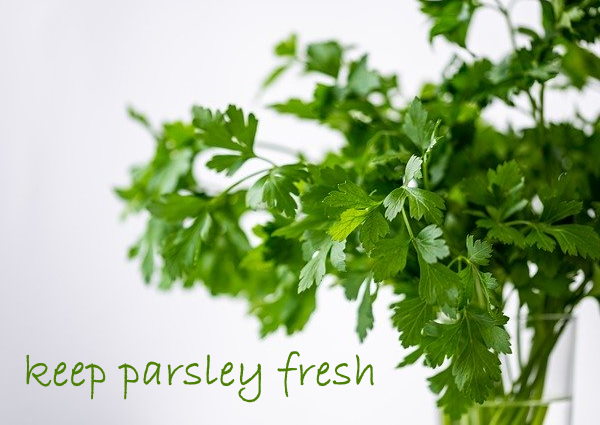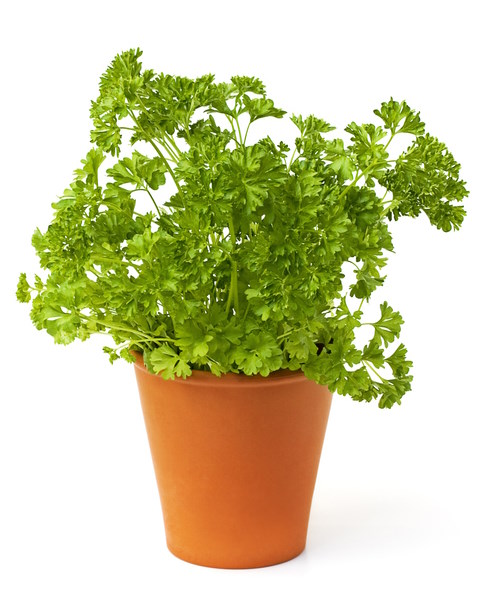Growing Parsley Indoors
Growing parsley indoors allows you to have a ready supply of this culinary herb year-round.
 Curly leaf parsley. Photo Credit: nile
Curly leaf parsley. Photo Credit: nileKnown botanically as Petroselinum, this genus is native to the warm, sunny Mediterranean. How big does parsley plant get? You can expect your plant to reach a height of about 12 inches (30 cm).
Parsley is a hardy biennial herb. Each branching stem is covered with finely serrated leaves. The two most common varieties are curly-leaf parsley (P. crispum), shown above, and Italian or flat-leaf parsley (P. crispum neopolitanum).
 Flatleaf Parsley
Flatleaf ParsleyCurly-leaf parsley combines a mild peppery flavor with a grass-like scent, and stays fresh longer once picked. To me, the better-tasting of the two is the flat-leaf Italian type. It has a mild pine flavor and stronger aroma.
Health Benefits of Parsley
If you think of parsley as just a garnish that gets pushed to the side of the plate, you should know there are many health benefits of parsley. Benefits that herbalists believe to help with digestion. And in China, parsley tea is often used to help lower high blood pressure.
A member of the carrot family (Umbelliferae), it's no wonder that parsley is packed with vitamins and minerals. Think about this before you dismiss this humble garnish: One cup of chopped fresh parsley contains more beta carotene than a carrot, nearly twice the vitamin C as an orange, 20 times as much iron as a serving of liver, and more calcium than a cup of milk.
Harvest and Keep Parsley
Harvesting parsley: Cut stems near the base, leaving at least 2-inch stems with a couple leaves for regrowth. The stems as well as the leaves can be used for cooking. Pick new growth often because the leaves quickly become tough. Never cut more than 1/3 of the plant at a time, to allow the plant to regrow.
 Flat-leaf parsley. Photo Credit: Kai Reschke
Flat-leaf parsley. Photo Credit: Kai ReschkeParsley is best used fresh. To keep cut parsley fresh, store it in the refrigerator. Submerge the stems in a glass of water with the leaves kept dry.
Freezing parsley is the next best thing to fresh. Wash and shake them dry. Freeze whole or chop the leaves and stems, then seal them in air-tight freezer bags.
Drying parsley takes away most of its flavor, but is a convenient way to keep this common herb on hand. Here's how to dry parsley: Cut off stems and tie in 1 inch bunches with string, leaving a loop for hanging. Hang them upside down and allow them to dry naturally in a cool, dry, dark place. Want to dry them in a hurry? Microwave them. Place several sprigs on a paper towel, cover with another paper towel and microwave at full power for about 2 minutes.
 Image by firina / istockphoto
Image by firina / istockphotoTips for Growing Parsley Indoors
Light: Bright light to full sun. At least 6 hours of direct sunlight per day during the growing season will help it grow lush and full. Turn plant for even growth because it will tend to grow toward the light source. If growing parsley under artificial light, keep the light 6 in (15 cm) above the plant and leave it on for 14 hours a day. This is the equivalent of 6 hours of sun.
Water: Keep soil evenly moist, but not soggy which can cause stem or root rot. Use a pot with drainage holes to prevent soggy soil.
Humidity: Average room (around 40% relative humidity)
Temperature: Average room temperatures 65-75°F/18-24°C
Soil: Good-quality, all-purpose potting mix. Use fresh potting mix to prevent any fungi from destroying your plants.
Fertilizer: Feed spring through fall with a water-soluble fertilizer.
Propagation: Seeds. Growing parsley from seed is a slow process because the seeds are slow to germinate. Soak seeds in warm water overnight before planting to speed up the process. Use a seed starting mix, kept lightly moist. Use a seedling heat mat, if needed, to maintain an even 70°F/21°C temperature night and day. It's a good idea to use artificial lights (See "Light" above) for seed starting. Sprouting can take up to 3 weeks.


